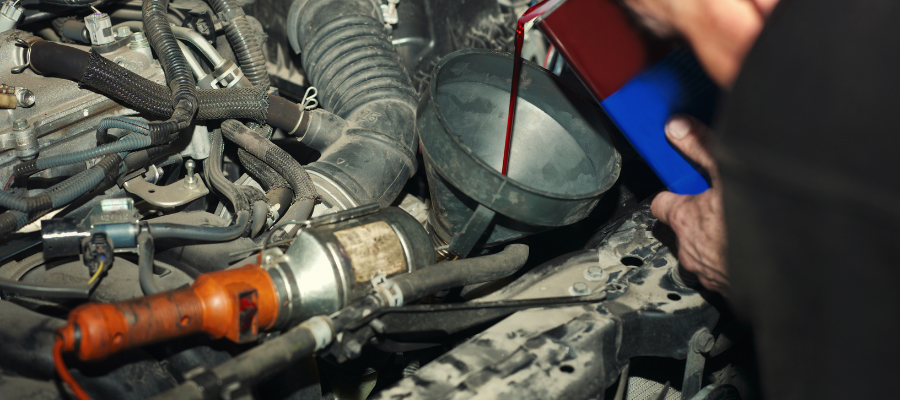How to change your car oil

Good clean oil improves the performance of your car while simultaneously extending the life of your engine. Many people delay when it comes to changing their car’s oil and this can be damaging to internal components of the motor.
So why do they stall? A significant proportion of drivers rely solely on mileage as a gauge for when they should change their oil. However, the age of the car, how the car is driven, and the quality of the oil used are all factors which determine when oil needs to be changed. Before we start with our guide to changing your oil, here are the easiest ways to tell when it needs to be changed in the first place.
How should you know when your oil needs to be changed?
1. Check oil or engine light has come on

This is the most obvious sign to identify that something in your oil level is awry. When you see your oil light illuminated then it’s time to check the dipstick (but more about that to follow). If you happen to miss your oil light warning, then your engine light will eventually turn on. If you see this lighting up, then it’s really time to pay attention to your oil! The engine light is your car’s way of warning you that things have deteriorated. When this occurs, the engine is usually at risk of damage due to lack of lubrication.
2. Engine noise and knocking sounds

Oil works to provide a protective layer between engine parts, avoiding metal to metal brushing and keeping the engine as quiet as possible. When your oil is overdue for a change the sound of your engine will increase. You might additionally hear knocking or even rumbling sounds that will signify that your engine is starting to tear due to a lack of lubrication.
3. Exhaust smoke

It’s normal for your exhaust to secrete translucent vapour every now and again however if this vapour turns to smoke, then it’s time to have your oil looked at as there may be a leak or a problem under the bonnet.
4. Dark murky oil

Clean oil is an amber shade in colour and is slightly transparent. When it has been in your oil filter for a while it begins to become filled with particles collected from your engine. Hence, it darkens in colour. When this begins to happen, it will not be immediately noticeable to you. However, if you actively check your oil regularly, you will notice that the colour of the oil is noticeably different to that which you put in originally. Hence, you’ll know it’s time for an oil change.
5. You’re covering a lot of ground

If you have been covering a lot of mileage in your car recently then you might need to schedule in an oil change quicker than you might think. While every car is different, it’s a standard norm that oil should be changed in a car every 4,800km or approximately every three months. Keep an eye on how much driving you’re doing. If you’ve been travelling a lot then it’s definitely time to check your oil.
So how do I change it?
1. Ensure you have all the equipment you need
Before you knuckle down to changing your oil ensure you have all the right equipment. You should have an oil filter, a bucket, a draining pan, some correctly sized spanners and the new oil for your car.
2. Warm up your car
Put your car in neutral and ensure that your handbrake is fully up. If you are in an automatic car, ensure that your car is in parking mode as your car will be stationary for a few minutes. Allow your car to run for about 5 or 10 minutes as this will help to warm up the engine. When you’re satisfied your car has heated up, shut it down. This will allow the oil to move out of the engine in a quicker and easier fashion.
3. Drain the oil
Once you are sure that the car is off and it’s safe to proceed. Remove the old oil. Place your bucket under the oil drain plug and begin loosening the bolt with your spanner. Once it has loosened sufficiently, remove it. Be careful of any steam lingering from the engine heat up. It should not take very long to drain the oil, approximately 10 minutes.
4. Find your oil filter
Set about finding your oil filter, this a round shaped canister that will be screwed against your engine approximately 5 inches deep.
5. Change the filter
Loosen the filter with your spanner and remove it. Now proceed with replacing the filter, ensuring you smear the new filter’s rubber seal with oil before reattaching it. You can use your hand to tighten it back in place as sometimes spanners are too aggressive for this aspect of the oil change.
6. Refill your oil
Before you begin refilling your oil, take the time to check that you have the recommended amount for your type of vehicle. You can check your manufacturer’s manual for this type of information. Locate the oil cap under the bonnet of your car and proceed to fill the oil to the required level. Replace the cap and ensure that your oil levels fall between high and low by using your dipstick. When you turn on your car your engine light should disappear after a couple of seconds.
7. Bonus tip
You should always ensure that you are using top quality oil for your engine as it can be damaging to your vehicle if you don’t. Read your manufacturer’s manual or ask your local mechanic for a recommendation on the best type of oil to use. Also remember, cars use oil very quickly, always keep an eye out for the warning signs and check oil regularly.










